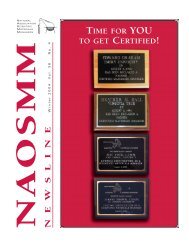Laboratory Safety Guidance
OSHA Lab Safety Guidance - ORS Optical Remote Sensing ...
OSHA Lab Safety Guidance - ORS Optical Remote Sensing ...
- No tags were found...
Create successful ePaper yourself
Turn your PDF publications into a flip-book with our unique Google optimized e-Paper software.
All areas in which radioactive<br />
materials are used or stored<br />
must conspicuously display the<br />
symbol for radiation hazards and<br />
access should be restricted to<br />
authorized personnel.<br />
The OSHA Ionizing Radiation standard requires precautionary<br />
measures and personnel monitoring for<br />
workers who are likely to be exposed to radiation<br />
hazards. Personnel monitoring devices (film<br />
badges, thermoluminescent dosimeters (TLD), pocket<br />
dosimeters, etc.) must be supplied and used if<br />
required to measure an individual’s radiation exposure<br />
from gamma, neutron, energetic beta, and X-<br />
ray sources. The standard monitoring device is a<br />
clip-on badge or ring badge bearing the individual<br />
assignee’s name, date of the monitoring period and<br />
a unique identification number. The badges are<br />
provided, processed and reported through a commercial<br />
service company that meets current requirements<br />
of the National Institute of Standards and<br />
Technology’s National Voluntary <strong>Laboratory</strong><br />
Accreditation Program (NIST NVLAP).<br />
It is important for employers to understand and follow<br />
all applicable regulations for the use of isotopes.<br />
In institutional settings, it is the responsibility<br />
of each institution to ensure compliance with local,<br />
state, and federal laws and regulations; to obtain<br />
licenses for official use of radioactive substances;<br />
and to designate a radiation safety officer (RSO) to<br />
oversee and ensure compliance with state and/or<br />
NRC requirements. Information on radioactive<br />
materials licenses may be obtained from the<br />
Department of Public Health from individual states<br />
or from the NRC.<br />
The following OSHA <strong>Safety</strong> and Health Topics Page<br />
provides links to technical and regulatory information<br />
on the control of occupational hazards from<br />
ionizing radiation:<br />
www.osha.gov/SLTC/radiationionizing/index.html.<br />
Non-ionizing Radiation<br />
Non-ionizing radiation is described as a series of<br />
energy waves composed of oscillating electric and<br />
magnetic fields traveling at the speed of light. Nonionizing<br />
radiation includes the spectrum of ultraviolet<br />
(UV), visible light, infrared (IR), microwave (MW),<br />
radio frequency (RF), and extremely low frequency<br />
(ELF). Lasers commonly operate in the UV, visible,<br />
and IR frequencies. Non-ionizing radiation is found<br />
in a wide range of occupational settings and can<br />
!<br />
WARNING<br />
RADIATION<br />
pose a considerable health risk to potentially<br />
exposed workers if not properly controlled.<br />
The following OSHA <strong>Safety</strong> and Health Topics Pages<br />
provide links to technical and regulatory information<br />
on the control of occupational hazards from nonionizing<br />
radiation and are available at:<br />
www.osha.gov/SLTC/radiation_nonionizing/index.html.<br />
Extremely Low Frequency Radiation (ELF)<br />
Extremely Low Frequency (ELF) radiation at 60 HZ is<br />
produced by power lines, electrical wiring, and electrical<br />
equipment. Common sources of intense exposure<br />
include ELF induction furnaces and high-voltage<br />
power lines.<br />
Radiofrequency and Microwave Radiation<br />
Microwave radiation (MW) is absorbed near the<br />
skin, while radiofrequency (RF) radiation may be<br />
absorbed throughout the body. At high enough<br />
intensities both will damage tissue through heating.<br />
Sources of RF and MW radiation include radio emitters<br />
and cell phones.<br />
Infrared Radiation (IR)<br />
The skin and eyes absorb infrared radiation (IR) as<br />
heat. Workers normally notice excessive exposure<br />
through heat sensation and pain. Sources of IR radiation<br />
include heat lamps and IR lasers.<br />
Visible Light Radiation<br />
The different visible frequencies of the electromagnetic<br />
(EM) spectrum are "seen" by our eyes as different<br />
colors. Good lighting is conducive to<br />
increased production, and may help prevent incidents<br />
related to poor lighting conditions. Excessive<br />
visible radiation can damage the eyes and skin.<br />
Ultraviolet Radiation (UV)<br />
Ultraviolet radiation (UV) has a high photon energy<br />
range and is particularly hazardous because there<br />
are usually no immediate symptoms of excessive<br />
exposure. Sources of UV radiation in the laboratory<br />
include black lights and UV lasers.<br />
Laser Hazards<br />
Lasers typically emit optical (UV, visible light, IR)<br />
radiations and are primarily an eye and skin hazard.<br />
Common lasers include CO2 IR laser; helium - neon,<br />
neodymium YAG, and ruby visible lasers, and the<br />
Nitrogen UV laser.<br />
LASER is an acronym which stands for Light<br />
Amplification by Stimulated Emission of Radiation.<br />
2 2<br />
Occupational <strong>Safety</strong> and<br />
Health Administration



